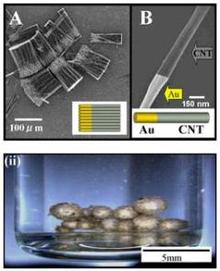A lot has been written in the last week about the Rice Mech E’s success in using nanoparticles to trap oil.
A team under Prof. Pulickel Ajayan hung gold nanowire on carbon nanotubes. These structures, which the team called nanobatons, then spontaneously surrounded oil droplets.
But the reporters ignored a key part of Dr. Ajayan’s quote, the goal of his research, to create "self-assembling, functional nanomaterials."
Translation: It’s Alive!
Well, not really. These are structures consisting almost entirely of carbon and other metals. There’s no hydrogen, no oxygen inside these structures. But the structures can spontaneously self assemble and function, which is how the original amino acids, deep in the sea, spawned the first primitive life forms billions of years ago.
There is no intelligence in these structures. They are not really "alive." Individual amino acids aren’t "alive" either. But when amino acids spontaneously self assemble and function to reproduce their own structures, they are taking the first steps down the road of life.
What we’re really talking about here, after you get rid of the scary imagery of science fiction, is something Rice scientists have been working on for decades, namely tearing down the walls separating organic and inorganic chemistry. Organic compounds combine into larger structures for reasons, scientific reasons, in response to stimulus from the environment. By creating nano-structures on an atom-by-atom which can mimic self assembly, and then then providing a specific stimulus, you get the result you seek.
Now here’s how the wall really gets breached.
The same process, if not the same nano-structures, can be used against unwanted organic compounds. They could either attack cancer cells directly or, more likely, the amino acid breakdowns in those cancer cells. Remember, to these nano-structures a cell is like a large building is to us.
Because Rice long ago broke down the walls separating disciplines, because it was necessary in order to do large projects on a small campus, there are bio-engineers and bio-chemists on the faculty who can run with this. It all fits together.
Not the wheel of life. The wheel of chemistry, of which the wheel of life is just a part.
P.S. — Back when I was at Rice three decades ago we used to look down at the Mech E’s as mere builders of bridges. Guess we’ll have to re-think that one, too.











